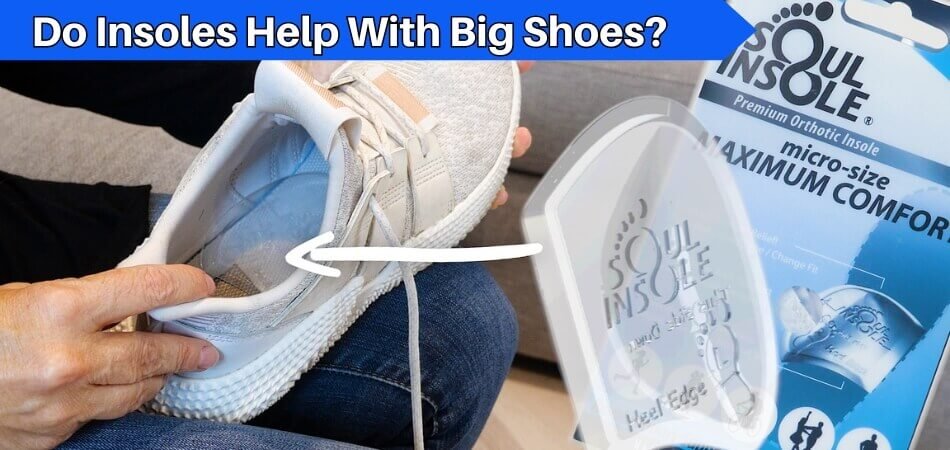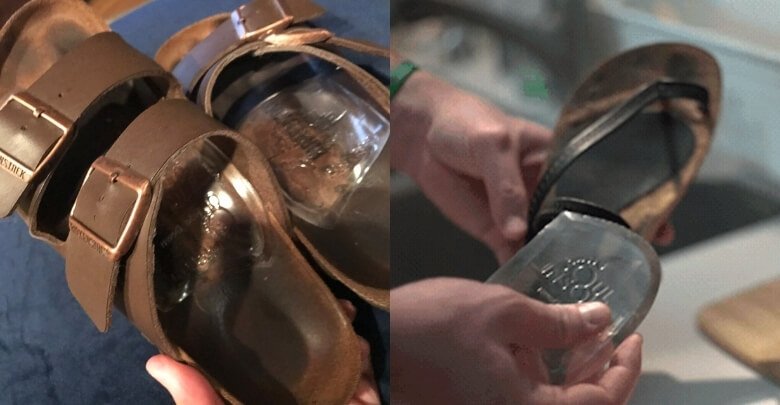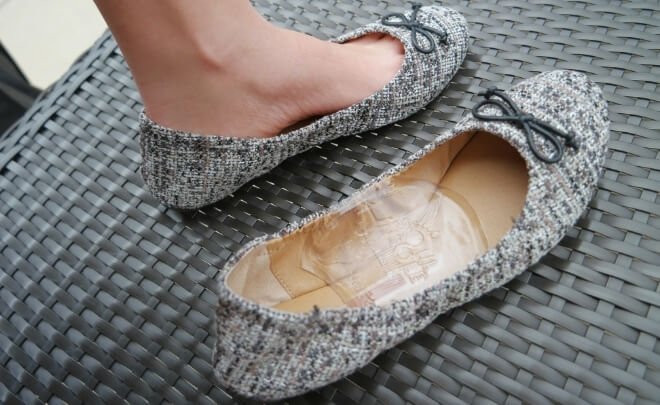Sometimes shoes feel too big, making it hard to walk comfortably. You might notice your feet slipping or feel extra space inside. This can be annoying and even cause foot pain. If you’ve asked yourself, “Do insoles help with big shoes?” you’re not alone.
The good news is, insoles can really help with big shoes. They fill up the extra space, so your shoes fit better and feel more comfortable. For very big shoes, full insoles work best. If the shoes are just a little too big, shorter insoles or heel liners can do the trick. Insoles also stop slipping and make walking easier.
Keep reading to find out how insoles can make your big shoes fit just right!
Do Insoles Help With Big Shoes?
Yes, insoles do help with big shoes. They fill extra space inside the shoe, making the fit snugger and more secure. Using the right insoles can stop your feet from sliding and add much-needed comfort. Insoles also offer support that can reduce pain during long walks or standing.

Full-Length Insoles for Large Shoes
Full-length insoles cover the entire footbed, providing support and cushioning. They work best when shoes are much bigger, filling most of the extra space. This helps your foot stay steady without slipping inside the shoe.
Adding a full insole can improve comfort by evenly distributing your weight. It also gives your foot better support during walking or standing. This type of insole is ideal if your shoes feel very loose.
Three-Quarter and Half-Length Insoles
Three-quarter and half-length insoles are smaller and fit only part of the shoe. They work well when shoes are slightly big but don’t need full coverage. These insoles avoid adding bulk in the toes while improving fit and comfort.
Your foot won’t move around inside the shoe with these shorter insoles. They also provide cushioning to reduce pressure and prevent blisters. People often choose these when they want a lighter, less bulky feel.
Heel Liners Prevent Slipping
Heel liners are thin pads placed at the back of the shoe. They stop your heels from slipping out while you walk or run. This makes your shoe feel tighter without filling the entire inside.
They also help reduce friction that can cause blisters around the heel. Heel liners are great for shoes that fit well everywhere except at the back. Using heel liners can save you from needing a full insole.
Arch Insoles Add Support and Fill Space
Arch insoles focus on supporting the foot’s arch, filling space where needed. They help improve your shoe’s fit by targeting specific areas rather than the whole foot. This can be especially helpful if your shoe feels loose around the middle.
Besides fit, arch insoles can reduce foot fatigue by supporting natural foot curves. They help distribute pressure and keep your foot stable inside the shoe. People with flat or high arches find these insoles especially useful.
Benefits of Using Insoles in Big Shoes
Insoles improve fit by stopping your feet from sliding inside large shoes. They also add cushioning, making walking or standing for long periods easier. Using insoles can reduce pain caused by pressure points and friction.
By improving stability, insoles prevent injuries and blisters often caused by loose footwear. They also make your shoe feel smaller without changing its size. These benefits make insoles a practical fix for shoes that don’t fit perfectly.
Choosing the Right Insole Size and Type
Picking the right insole size ensures the best comfort and fit in your shoes. Using too thick or large insoles can make shoes tight and uncomfortable. Testing different types, like the popular Soul Insole, helps you find the perfect match.
Also, combining insoles with toe inserts can improve fit if the shoes still feel loose. Always check the shoe’s space before buying insoles to avoid bulkiness. This approach saves money and keeps your feet comfortable all day.
Why is It a Cause for Concern for Big Shoe Owners While Using Insoles?
Using insoles to fix big shoes seems simple, but it can bring new problems if not done right. Big shoe owners must be careful when choosing and using insoles. This guide explains the main concerns they should know before trying insoles.

Risk of Poor Fit and Instability
If insoles are too thick, they can lift the foot too high inside the shoe. This causes the heel to slip out, making walking unstable. Unstable feet increase the chance of trips and falls. Proper sizing is key to avoiding these risks.
Friction and Skin Issues
When feet move too much inside big shoes, the skin can rub and cause blisters. Some insoles do not hold the foot firmly, increasing friction problems. Pressure points from the wrong insoles can cause sores and calluses. Choosing supportive insoles helps reduce these issues.
Discomfort and Circulation Problems
Thick or tight insoles can press on blood vessels and reduce circulation in the feet. Poor blood flow leads to numbness, pain, and discomfort during walking. Insoles must allow enough room for foot movement. Comfort should always be a priority.
Altered Gait and Posture
Wearing big shoes or the wrong insoles can change how you walk or stand. This may cause pain in the knees, hips, or back over time. Poor posture also increases the risk of long-term body problems. Proper insoles support natural foot alignment.
Insole Quality and Fit
Low-quality insoles often lack durability and can cause joint pain or blisters. Ill-fitting insoles worsen foot problems instead of fixing them. Some people need custom orthotics for serious foot issues. Investing in good insoles prevents discomfort.
Shoe Size Considerations
Adding insoles takes up space inside the shoe, reducing room for the foot. If the shoe is very big, insoles help, but bulky ones might make the shoe too tight. Sometimes, a different shoe size is necessary for comfort. Balancing fit and space is important.
Can Insoles Truly Make Big Shoes Feel Smaller and More Secure?
Yes, insoles can make big shoes feel smaller and more secure by filling the extra space inside. They take up room and help shoes fit better in length and width. When shoes fit well, feet don’t slide or slip around. This makes walking easier and more comfortable for people with big shoes.
Full-length insoles cover the whole foot and support the heel, arch, and toes to keep feet steady. Using insoles for better heel fit helps stop your feet from slipping inside the shoe. Insoles also soften the foot, absorb shock, and reduce pain from pressure points. It’s important to pick the right thickness so your shoes don’t feel too tight or squeeze your feet.
What Should You Know Before Using Insoles for Big Shoes?
Insoles can be a helpful solution for improving the fit of slightly oversized shoes. They add cushioning, provide support, and reduce excess space inside the shoe. However, like any footwear accessory, it’s important to choose the right product and understand its limitations for the best results.

Best for Mild Size Adjustments
Insoles are most effective when shoes are only slightly too big. While they can improve fit and comfort, they may not fully compensate for shoes that are several sizes too large. In such cases, a combination of insoles, heel grips, or toe fillers may offer better results.
Choosing the Right Fit for Comfort
Comfort depends on selecting insoles that match your foot shape and shoe type. Ill-fitting or overly bulky insoles might cause discomfort or pressure in certain areas. Testing a few options can help you find one that complements your foot mechanics and enhances support.
Short-Term vs. Long-Term Solutions
Insoles can offer a convenient short-term fix, especially if you’re between sizes or need to improve comfort. However, they may not replace the benefits of wearing properly fitted shoes, especially for daily use or long periods of standing and walking.
Support That Matches Your Needs
Some insoles feature added arch support or cushioning designed to aid posture and reduce fatigue. While this can be beneficial, individuals with specific foot needs should ensure that any new support doesn’t interfere with their natural gait or foot strength. Consulting a specialist can help if you’re unsure.
Ensuring a Secure Fit
For insoles to work properly, they should lie flat and not create any ridges or bumps inside the shoe. A well-fitted insole enhances stability and walking comfort, while a poor fit may lead to awkward movement or reduced balance.
Finding the Right Insole Takes Time
With various materials, thicknesses, and designs available, finding the right insole might require a bit of trial and error. Taking the time to explore different options ensures better comfort and long-term satisfaction.
What Types of Insoles Are Best for Shoes That Are Slightly Too Large?
When shoes feel just a little too big, the right insoles can make a big difference. Choosing the correct type improves comfort and helps your shoes fit better. This guide explains the best insoles for shoes that are slightly too large.
Three-Quarter Length Insoles
Three-quarter insoles cover the heel and most of the foot but leave toes free. This design prevents crowding in the toe box while improving fit. They work well in shoes that are just a bit too big. These insoles keep your feet snug without adding extra bulk.
Full-Length Insoles
Full-length insoles cover the entire footbed, from heel to toe. They provide cushioning and support for the whole foot, making shoes feel more secure. These insoles suit moderately large shoes that need extra space. They offer steady support during walking or standing.
Heel Liners or Heel Grips
Heel liners are thin pads placed at the back of the shoe to stop heel slipping. They push your foot slightly forward, improving fit without bulk inside the shoe. Heel grips are perfect when only the heel area feels loose. They prevent discomfort and keep feet stable.
Arch Support Insoles
Arch support insoles fill space along the midfoot where arch support may be missing. They improve foot alignment and stability, which helps prevent foot fatigue. These insoles are great for slightly large shoes lacking proper arch support. Better alignment can reduce foot pain during use.
Memory Foam or Gel Insoles
Memory foam or gel insoles provide cushioning, shock absorption, and a snug fit inside shoes. They adapt to your foot shape and can be trimmed for a perfect fit. Products like Dr. Scholl’s WORK Massaging Gel offer comfort for many shoe types. These flexible insoles reduce pressure and improve walking comfort.
Customizable Insoles
Customizable insoles allow you to trim excess material for a tailored fit inside any shoe. This helps avoid discomfort caused by too much bulk or poor sizing. These insoles work well for shoes that need precise adjustments. They give you control over fit and comfort.
How to Choose the Right Insole Thickness to Fit Oversized Shoes?
Choosing the right insole thickness is key to making oversized shoes fit comfortably. Insoles that are too thick or too thin can cause discomfort or poor fit. Here are some helpful tips to guide you in picking the best thickness for your shoes.

Measure the Shoe Space First
- Always check how much extra room is inside your shoe before selecting an insole. This helps avoid buying insoles that make the shoe too tight or too loose.
- Use a ruler or shoe measuring tool to find available space from the footbed to the shoe top. Knowing this helps when adjusting fit with insoles for the best comfort.
Start with Thin Insoles
- Begin by trying thin insoles to avoid overcrowding the shoe and feeling too tight. Thin insoles provide slight cushioning without reducing too much space inside the shoe.
- Thin insoles also allow more natural foot movement and avoid restricting blood flow or causing pressure points.
Consider Full vs. Partial Insoles
- Full insoles add thickness throughout the shoe and offer more support, but can reduce shoe space greatly. Partial insoles like three-quarter length can fill only key areas without crowding the entire foot.
- Deciding between full and partial insoles depends on where your shoe feels loose and which areas need extra support or padding.
Test Comfort and Fit Regularly
- Try walking with the insole inside your shoe to check if it feels comfortable and stable. If you feel tightness, numbness, or slipping, try a different thickness or type.
- Comfort should be your top priority, so adjust the thickness until your foot feels secure without pain or restriction.
Trim Insoles if Needed
- Many insoles come with guidelines for trimming excess material to perfectly fit your shoe size. Custom trimming helps avoid bulkiness and improves overall comfort inside oversized shoes.
- Carefully trim small amounts at a time and test the fit often to avoid removing too much or causing fit problems.
Replace Worn-Insoles on Time
- Insoles lose thickness and cushioning over time, so replace them regularly for ongoing comfort and proper fit. Old insoles may feel thin and stop filling the extra shoe space effectively.
- Keeping insoles in good condition helps maintain stability and support, preventing foot pain during daily activities.
Frequently Asked Questions About Insoles for Big Shoes
Many people wonder if insoles can really help when their shoes feel too big. Insoles are a popular fix to improve shoe fit and comfort. Here are 10 common questions about using insoles in big shoes, answered clearly.
Can Insoles Prevent Foot Slipping in Big Shoes?
Yes, insoles help reduce foot slipping by filling extra space and providing grip inside the shoe. This keeps your foot more stable and prevents uncomfortable sliding while walking or running.
Do Insoles Improve Shoe Stability for Big Shoes?
Insoles improve shoe stability by supporting the foot’s shape and filling gaps. This added support helps prevent the foot from moving around inside the shoe, reducing the risk of twisting or tripping.
Are Insoles Suitable for All Types of Big Shoes?
Most insoles work well with many shoe types, including sneakers, boots, and dress shoes. However, choosing the right shape and thickness is important to avoid overcrowding and maintain comfort in different shoes.
How Do Insoles Affect Shoe Breathability?
Some insoles can reduce breathability by covering the shoe’s footbed, potentially causing feet to sweat more. Look for insoles made from breathable materials like gel or foam to maintain airflow and comfort.
Can Insoles Help With Arch Support in Big Shoes?
Yes, arch support insoles help fill space and provide extra stability for the midfoot. This support can reduce foot fatigue and pain when wearing slightly large shoes for long periods.
Will Insoles Make My Shoes Feel Too Tight?
Insoles can make shoes feel tighter if they are too thick or improperly sized. It’s important to measure the shoe space and pick insoles with the right thickness to avoid discomfort.
Can Insoles Be Used Along With Other Inserts for Big Shoes?
Yes, insoles can be combined with heel liners or toe fillers to improve fit. Using multiple inserts helps customize the shoe interior for a snug and comfortable fit.
Do Insoles Help Prevent Blisters in Big Shoes?
Insoles reduce foot movement inside shoes, lowering friction that causes blisters. They also cushion pressure points, protecting skin from irritation caused by oversized shoes.
How Long Do Insoles Last When Used in Big Shoes?
Insoles usually last 6 to 12 months, depending on use and material quality. Regularly check for wear and replace them to keep your shoes comfortable and supportive.
Can Insoles Improve Posture When Wearing Big Shoes?
Proper insoles support foot alignment, which can improve overall posture. By stabilizing the foot inside big shoes, they help reduce strain on knees, hips, and back during walking or standing.
Closing Remarks
Insoles can really help make big shoes fit better and feel more comfortable. They fill the extra space inside the shoe and stop your feet from slipping around. Many people wonder, do insoles help with big shoes?
The answer is yes, as long as you pick the right type and thickness. It’s important to choose insoles that fit well with your shoes and feet. This way, you avoid feeling tight or unstable. With the right insoles, you can enjoy wearing your shoes without pain or discomfort every day.






